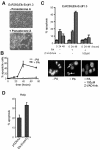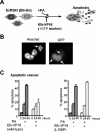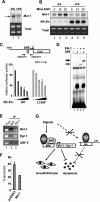Ternary complex factor-serum response factor complex-regulated gene activity is required for cellular proliferation and inhibition of apoptotic cell death
- PMID: 15542842
- PMCID: PMC529045
- DOI: 10.1128/MCB.24.23.10340-10351.2004
Ternary complex factor-serum response factor complex-regulated gene activity is required for cellular proliferation and inhibition of apoptotic cell death
Abstract
Members of the ternary complex factor (TCF) subfamily of the ETS-domain transcription factors are activated through phosphorylation by mitogen-activated protein kinases (MAPKs) in response to a variety of mitogenic and stress stimuli. The TCFs bind and activate serum response elements (SREs) in the promoters of target genes in a ternary complex with a second transcription factor, serum response factor (SRF). The association of TCFs with SREs within immediate-early gene promoters is suggestive of a role for the ternary TCF-SRF complex in promoting cell cycle entry and proliferation in response to mitogenic signaling. Here we have investigated the downstream gene regulatory and phenotypic effects of inhibiting the activity of genes regulated by TCFs by expressing a dominantly acting repressive form of the TCF, Elk-1. Inhibition of ternary complex activity leads to the downregulation of several immediate-early genes. Furthermore, blocking TCF-mediated gene expression leads to growth arrest and triggers apoptosis. By using mutant Elk-1 alleles, we demonstrated that these effects are via an SRF-dependent mechanism. The antiapoptotic gene Mcl-1 is identified as a key target for the TCF-SRF complex in this system. Thus, our data confirm a role for TCF-SRF-regulated gene activity in regulating proliferation and provide further evidence to indicate a role in protecting cells from apoptotic cell death.
Figures







Similar articles
-
Integration of growth factor signals at the c-fos serum response element.Philos Trans R Soc Lond B Biol Sci. 1996 Apr 29;351(1339):551-9. doi: 10.1098/rstb.1996.0054. Philos Trans R Soc Lond B Biol Sci. 1996. PMID: 8735278
-
Myocardin and ternary complex factors compete for SRF to control smooth muscle gene expression.Nature. 2004 Mar 11;428(6979):185-9. doi: 10.1038/nature02382. Nature. 2004. PMID: 15014501
-
FLI1 and EWS-FLI1 function as ternary complex factors and ELK1 and SAP1a function as ternary and quaternary complex factors on the Egr1 promoter serum response elements.Oncogene. 1997 Jan 16;14(2):213-21. doi: 10.1038/sj.onc.1200839. Oncogene. 1997. PMID: 9010223
-
Ets ternary complex transcription factors.Gene. 2004 Jan 7;324:1-14. doi: 10.1016/j.gene.2003.09.028. Gene. 2004. PMID: 14693367 Review.
-
Functional versatility of transcription factors in the nervous system: the SRF paradigm.Trends Neurosci. 2009 Aug;32(8):432-42. doi: 10.1016/j.tins.2009.05.004. Epub 2009 Jul 28. Trends Neurosci. 2009. PMID: 19643506 Review.
Cited by
-
Transcription factors Elk-1 and SRF are engaged in IL1-dependent regulation of ZC3H12A expression.BMC Mol Biol. 2010 Feb 6;11:14. doi: 10.1186/1471-2199-11-14. BMC Mol Biol. 2010. PMID: 20137095 Free PMC article.
-
Heteromerization of GPR55 and cannabinoid CB2 receptors modulates signalling.Br J Pharmacol. 2014 Dec;171(23):5387-406. doi: 10.1111/bph.12850. Epub 2014 Sep 5. Br J Pharmacol. 2014. PMID: 25048571 Free PMC article.
-
Dual Specificity Phosphatase 5, a Specific Negative Regulator of ERK Signaling, Is Induced by Serum Response Factor and Elk-1 Transcription Factor.PLoS One. 2015 Dec 21;10(12):e0145484. doi: 10.1371/journal.pone.0145484. eCollection 2015. PLoS One. 2015. PMID: 26691724 Free PMC article.
-
Regulation of serum response factor activity and smooth muscle cell apoptosis by chromodomain helicase DNA-binding protein 8.Am J Physiol Cell Physiol. 2010 Nov;299(5):C1058-67. doi: 10.1152/ajpcell.00080.2010. Epub 2010 Aug 25. Am J Physiol Cell Physiol. 2010. PMID: 20739623 Free PMC article.
-
SRF Co-factors Control the Balance between Cell Proliferation and Contractility.Mol Cell. 2016 Dec 15;64(6):1048-1061. doi: 10.1016/j.molcel.2016.10.016. Epub 2016 Nov 17. Mol Cell. 2016. PMID: 27867007 Free PMC article.
References
-
- Badiani, P., P. Corbella, D. Kioussis, J. Marvel, and K. Weston. 1994. Dominant interfering alleles define a role for c-Myb in T-cell development. Genes Dev. 8:770-782. - PubMed
-
- Bertolotto, C., J. E. Ricci, F. Luciano, B. Mari, J. C. Chambard, and P. Auberger. 2000. Cleavage of the serum response factor during death receptor-induced apoptosis results in an inhibition of the c-FOS promoter transcriptional activity. J. Biol. Chem. 275:12941-12947. - PubMed
-
- Cesari, F., S. Brecht, K. Vintersten, L. G. Vuong, M. Hofmann, K. Klingel, J. J. Schnorr, S. Arsenian, H. Schild, T. Herdegen, F. F. Wiebel, and A. Nordheim. 2004. Mice deficient for the Ets transcription factor Elk-1 show normal immune responses and mildly impaired neuronal gene activation. Mol. Cell. Biol. 24:294-305. - PMC - PubMed
Publication types
MeSH terms
Substances
LinkOut - more resources
Full Text Sources
Molecular Biology Databases
Miscellaneous
